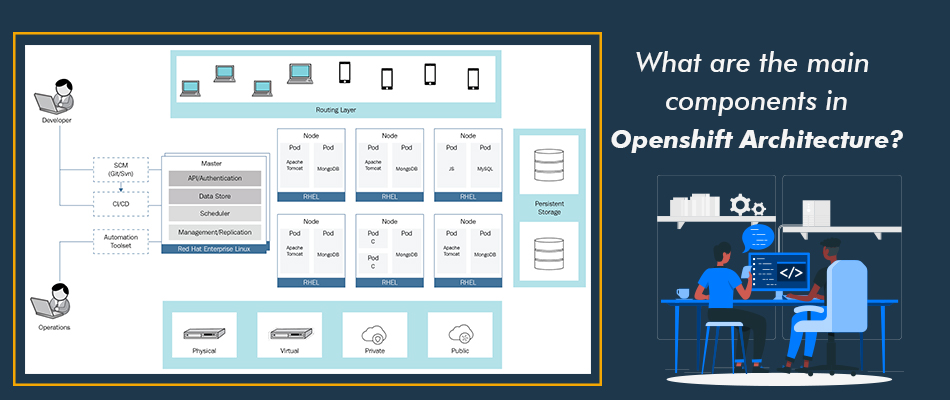Ever since technology has started to expand, there are several terms that we hear on a regular basis and some newer terms that get introduced into the market frequently. One such term is “OpenShift.” We are sure you have heard of this term, and others like “Red Hat OpenShift Course,” “Red Hat OpenShift Training,” and more like this. But, What is OpenShift? What are the Components of OpenShift? And what is the networking model of OpenShift? We are sure you are willing to learn all about OpenShift, and this blog is here to serve your purpose.
Introduction to OpenShift Architecture
OpenShift is a container application platform that was developed by Red Hat. It is based on the Kubernetes container orchestration system and provides a platform for developing, deploying, and managing containerized applications. OpenShift aims to simplify the process of deploying and managing applications in the cloud, making it easier for organizations to adopt containerization and DevOps practices.
OpenShift provides a complete platform for deploying and managing applications, from the development phase to production. It consists of a set of core components that work together to provide a complete solution for containerized applications. The core components include Kubernetes, Docker, Atomic Host, Source-to-Image (S2I), and Container Networking. Additionally, OpenShift provides a number of additional components, such as a Registry, Router, Service Catalog, Template Service Broker, and Web Console, which provide additional functionality and management capabilities.
Benefits of OpenShift
There are several benefits of using OpenShift as a platform for deploying and managing containerized applications. Firstly, OpenShift provides a complete platform for developing and deploying containerized applications, making it easier for organizations to adopt containerization and DevOps practices. Additionally, OpenShift is based on Kubernetes, which is one of the most widely used container orchestration systems, providing a high level of compatibility and interoperability with other tools and systems. There is a Red Hat Openshift Course available that you can get to learn more about OpenShift.
Another advantage of OpenShift is that it provides a flexible and scalable platform for deploying and managing applications, allowing organizations to easily adapt to changing demands and requirements. Additionally, OpenShift provides a range of integrated security features, such as role-based access control (RBAC) and security context constraints (SCCs), which help to secure the platform and applications deployed on it.
Key Features of OpenShift
OpenShift provides a complete and flexible platform for deploying and managing containerized applications, making it easier for organizations to adopt containerization and DevOps practices. With its key features, such as integrated security, management and monitoring tools, and automated deployment, OpenShift provides a solution that helps organizations to simplify the process of deploying and managing applications in the cloud.
The key features of OpenShift include:
- Complete Platform: OpenShift provides a complete platform for deploying and managing containerized applications, from development to production.
- Based on Kubernetes: OpenShift is based on Kubernetes, which provides a high level of compatibility and interoperability with other tools and systems.
- Flexible and Scalable: OpenShift provides a flexible and scalable platform for deploying and managing applications, allowing organizations to easily adapt to changing demands and requirements.
- Integrated Security: OpenShift provides a range of integrated security features, such as role-based access control (RBAC) and security context constraints (SCCs), which help to secure the platform and applications deployed on it.
- Management and Monitoring: OpenShift provides a number of tools and features for managing and monitoring applications, such as the Web Console, which provides a graphical user interface for managing the platform, and the Router, which provides load balancing and traffic routing for applications.
- Automated Deployment: OpenShift provides a range of automated deployment features, such as Source-to-Image (S2I), which automates the process of building and deploying containerized applications.
- Integration with CI/CD: OpenShift provides integration with CI/CD pipelines, allowing organizations to easily build and deploy applications in a continuous and automated manner.
Core Components of OpenShift Architecture
A. Kubernetes
Kubernetes is an open-source system for automating the deployment, scaling, and management of containerized applications. It was originally developed by Google and has since become the industry standard for container orchestration. Kubernetes provides a set of APIs and tools for managing containers, as well as a declarative configuration model that makes it easy to manage and deploy complex applications. Become a pro at the OpenShift Architecture by learning about it through a Red Hat Openshift course and get yourself a Red Hat Openshift certification.
In OpenShift, Kubernetes is used as the underlying platform for managing containers and applications. OpenShift extends the Kubernetes API to provide additional functionality and integrates with other components, such as the Kubernetes Dashboard, to provide a complete solution for containerized applications. Kubernetes provides a number of key features for managing containers, including:
- Container orchestration: Kubernetes provides the core functionality for managing and deploying containers, including scaling, self-healing, and rollouts. This makes it easier to manage large-scale container deployments, even in complex and dynamic environments.
- Load balancing: Kubernetes provides automatic load balancing for containers, ensuring that applications are always available and responsive, even in the event of failures or changes in demand.
- Self-healing: Kubernetes provides built-in self-healing functionality, which automatically restarts containers in the event of failures and ensures that the desired state of the system is always maintained.
- Storage management: Kubernetes provides a flexible storage model that allows you to easily manage and persist data for containers. This makes it easier to manage stateful applications, such as databases, and ensures that data is always available, even in the event of failures.
B. Docker
Docker is a popular open-source platform for building, shipping, and running distributed applications. It provides a simple and efficient way to package and deploy applications as containers, making it easier to deploy and manage applications across different environments.
In OpenShift, Docker is used to package and deploy applications as containers. OpenShift provides a standard format for building and deploying containers, making it easier to manage and deploy applications across different environments. Docker also provides a number of features for managing containers, including:
- Portability: Docker containers are designed to be portable, which makes it easier to deploy and run applications across different environments.
- Security: Docker provides a secure and isolated environment for running containers, ensuring that applications are protected from potential security risks.
- Scalability: Docker provides a scalable platform for deploying and managing containers, making it easier to manage large-scale deployments and respond to changes in demand.
C. Atomic Host
Atomic Host is a minimal host operating system that provides a stable and secure environment for deploying and running containers. It provides a number of features for managing and maintaining the stability and security of the system, including:
- Automatic updates: Atomic Host provides automatic updates, ensuring that the system is always up-to-date with the latest security patches and bug fixes.
- System rollback: Atomic Host provides a system rollback feature, which allows you to easily revert to a previous version of the system in the event of problems or failures.
- Version management: Atomic Host provides version management, making it easier to manage different versions of the system and ensure that the desired version is always deployed.
In OpenShift, Atomic Host provides the underlying operating system for the platform, providing a stable and secure environment for deploying and running containers. Additionally, Atomic Host provides a number of features for maintaining the stability and security of the system, making it easier to manage and deploy applications in production environments.
D. Source-to-Image (S2I)
Source-to-Image (S2I) is a tool for building reproducible container images from source code. It provides a simple and efficient way to build and deploy applications, making it easier to manage and deploy complex applications.
In OpenShift, S2I is used to automate the process of building and deploying applications. S2I provides a standard format for building and deploying applications, making it easier to manage and deploy applications across different environments. S2I also provides a number of features for building and deploying applications, including:
- Reproducibility: S2I provides a reproducible build process, making it easy to build and deploy applications consistently, even in complex and dynamic environments.
- Flexibility: S2I provides a flexible build process, making it easy to build and deploy applications using different build tools and languages.
- Automation: S2I automates the build process, making it easier to manage and deploy applications in large-scale environments.
E. Container Networking
Container networking provides the infrastructure for connecting containers and managing communication between containers in OpenShift, making it easier to manage and deploy complex applications in large-scale environments. In OpenShift, container networking provides a number of features for managing network communication, including:
- Load balancing: Container networking provides automatic load balancing for containers, ensuring that applications are always available and responsive, even in the event of failures or changes in demand.
- Security: Container networking provides security features for managing network communication, including encryption and access controls, ensuring that applications are protected from potential security risks.
- Scalability: Container networking provides a scalable infrastructure for managing network communication, making it easier to manage large-scale deployments and respond to changes in demand.
Additional Components in OpenShift Architecture
A. Registry
The registry is a central repository for storing and managing Docker images. In OpenShift, the registry is used to store images that are used to deploy applications. It provides a number of features for managing and storing images, including:
Version control: The registry provides version control for images, making it easier to manage and maintain different versions of an application.
Security: The registry provides security features for managing images, including access controls and encryption, ensuring that images are protected from potential security risks.
Scalability: The registry provides a scalable infrastructure for storing and managing images, making it easier to manage large-scale deployments and respond to changes in demand.
B. Router
The router is a component in OpenShift that provides load balancing and routing capabilities for applications. It provides a number of features for managing and routing network traffic, including:
- Load balancing: The router provides automatic load balancing for applications, ensuring that they are always available and responsive, even in the event of failures or changes in demand.
- Routing: The router provides routing capabilities for applications, allowing them to be accessed from external networks and the internet.
- Security: The router provides security features for managing network communication, including encryption and access controls, ensuring that applications are protected from potential security risks.
C. Service Catalog
The service catalog is a component in OpenShift that provides a centralized repository for managing services and service instances. It provides a number of features for managing services and service instances, including:
- Management: The service catalog provides a centralized repository for managing services and service instances, making it easier to manage and maintain complex services and service instances.
- Discovery: The service catalog provides a mechanism for discovering and accessing services, making it easier to access and consume services from other parts of the system.
- Brokering: The service catalog acts as a broker for services, connecting consumers and providers of services and managing the communication between them.
- Abstraction: The service catalog provides an abstract representation of services, hiding the implementation details and making it easier to manage and consume services.
D. Template Service Broker
The template service broker is a component in OpenShift that provides a centralized repository for managing and consuming application templates. Application templates are pre-configured definitions of an application, including all of the necessary components and configuration settings. The template service broker provides a number of features for managing and consuming application templates, including:
- Management: The template service broker provides a centralized repository for managing and consuming application templates, making it easier to manage and maintain complex applications.
- Discovery: The template service broker provides a mechanism for discovering and accessing application templates, making it easier to access and consume templates from other parts of the system.
- Automation: The template service broker automates the process of creating and deploying applications from templates, making it easier to manage and deploy complex applications.
E. Web Console
The web console is a component in OpenShift that provides a graphical user interface for managing and deploying applications. The web console provides a number of features for managing and deploying applications, including:
- Management: The web console provides a centralized repository for managing and deploying applications, making it easier to manage and maintain complex applications.
- Visualization: The web console provides a visual representation of applications, making it easier to understand and manage complex applications.
- Automation: The web console automates the process of creating and deploying applications, making it easier to manage and deploy complex applications.
OpenShift Networking Model
OpenShift provides a flexible and scalable networking model for applications, allowing them to communicate with each other and with external networks. It provides features for load balancing, routing, and security, and allows applications and services to communicate effectively and securely with each other and with external networks. The networking model in OpenShift is based on industry-standard networking technologies and provides a number of features for managing and securing network communication, including:
- Load balancing: OpenShift provides automatic load balancing for applications, ensuring that they are always available and responsive, even in the event of failures or changes in demand.
- Routing: OpenShift provides routing capabilities for applications, allowing them to be accessed from external networks and the internet.
- Security: OpenShift provides security features for managing network communication, including encryption and access controls, ensuring that applications are protected from potential security risks.
B. NetworkPlugins
OpenShift provides a number of network plugins, which are used to manage network communication in the system. Network plugins provide a number of features for managing network communication, including:
- Load balancing: Network plugins provide load balancing capabilities for applications, ensuring that they are always available and responsive, even in the event of failures or changes in demand.
- Routing: Network plugins provide routing capabilities for applications, allowing them to be accessed from external networks and the internet.
- Security: Network plugins provide security features for managing network communication, including encryption and access controls, ensuring that applications are protected from potential security risks.
C. Service Network
The service network in OpenShift is used for communication between services in the system. Services are abstract representations of applications, and the service network provides a mechanism for services to communicate with each other. The service network provides a number of features for managing service communication, including:
- Load balancing: The service network provides load balancing capabilities for services, ensuring that they are always available and responsive, even in the event of failures or changes in demand.
- Routing: The service network provides routing capabilities for services, allowing them to be accessed from other parts of the system.
- Security: The service network provides security features for managing service communication, including encryption and access controls, ensuring that services are protected from potential security risks.
D. Cluster Network
The cluster network in OpenShift is used for communication between nodes in the system. You will learn about it during your Red Hat Openshift Training. Nodes are physical or virtual machines that are used to host applications and services. The cluster network provides a number of features for managing communication between nodes, including:
- Load balancing: The cluster network provides load balancing capabilities for nodes, ensuring that they are always available and responsive, even in the event of failures or changes in demand.
- Routing: The cluster network provides routing capabilities for nodes, allowing them to communicate with other parts of the system, such as external networks and the internet.
- Security: The cluster network provides security features for managing communication between nodes, including encryption and access controls, ensuring that nodes are protected from potential security risks.
OpenShift is a powerful platform for managing containers and applications, and it provides a flexible and scalable architecture for deploying and managing applications in a cloud-native environment, which can be learned by enrolling in a Red Hat Openshift training. The architecture of OpenShift is based on industry-standard technologies, including Kubernetes, Docker, Atomic Host, Source-to-Image (S2I), and container networking. Additionally, OpenShift provides a number of additional components, including the registry, router, service catalog, template service broker, and web console, to further enhance the functionality of the platform.
The future of OpenShift architecture is bright, with a focus on further enhancing the platform to provide additional features and capabilities for organizations and developers. As cloud-native technologies continue to evolve and become more widely adopted, OpenShift will continue to provide a flexible and scalable architecture for deploying and managing applications in a cloud-native environment. Several openshift courses are becoming popular, the best of which are Red Hat OpenShift Certification, Red Hat OpenShift Course, and Red Hat OpenShift Training.
In conclusion, OpenShift provides a powerful platform for managing containers and applications, with a flexible and scalable architecture that provides a number of advantages for organizations and developers. The future of OpenShift architecture is exciting, with a focus on further enhancing the platform to provide additional features and capabilities. To make your career in this field, enroll yourself in Red Hat OpenShift Course, and become a pro.






